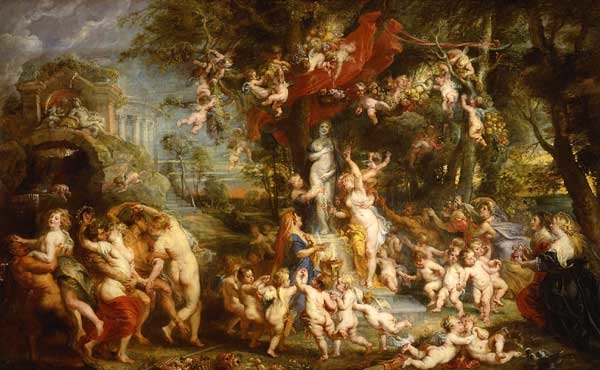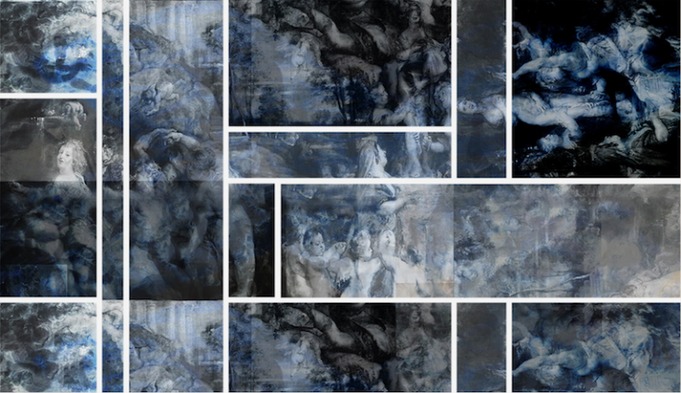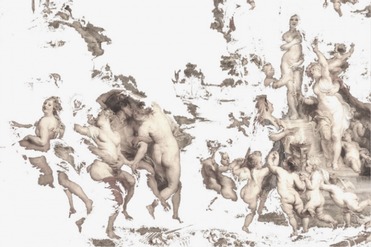INTERVIEW: Inga Krymskaya on her latest project 3045 Variations on The Feast of Venus
Above: Ben Street and Inga Krymova at the exhibition opening at Hay Hill Gallery / Courtesy of Hay Hill Gallery
Inga Krymskaya is a contemporary visual artist. Born in Russia, Inga moved to the Netherlands in 1993. Having lived in Amsterdam for the past 23 years, she is now London-based. Her work has been exhibited at various art fairs and galleries across the world, including G-77 Gallery in Kyoto, VK Gallery in Amsterdam, Wall Gallery in Amsterdam, Arttitud San Francisco, Berliner Liste (Germany), SCOPE (New York, Basel), and the Antwerp EXPO. 3045 Variations on The Feast of Venus is her current project, involving the adaptation and reinvention of the Flemish Baroque painting by Rubens’ entitled The Feast of Venus. Inga has completed over 80 variations of the painting herself after developing a fascination for the painting and its universal theme of love, spirituality and the remaking of artworks. We met with Inga to talk about her work on the project and** an international call to artists to participate in 3045 Variations on The Feast of Venus.
Anna Prosvetova: Inga, why did you decide to start this project with Rubens’ The Feast of Venus? Could you tell us about your first encounter with the painting and what was the most striking about the work?
Inga Krymskaya: My first proper encounter with the painting was actually thanks to the art historian Ben Street who gave a talk about Rubens at Christie’s. It’s quite amazing that he came back to give a lecture during the opening of my exhibition at Hay Hill Gallery last year. I was struck by the energy emanating from this painting – an amalgamation of young and old, male and female – all engaged in an act of love. To me, it is not an erotic kind of love, but a universal representation of love. Also, the fact that it was inspired by a painting by Titian in the first place originated the whole ‘variation’ theme.

Peter Paul Rubens, The Feast of Venus, c. 1636/37 © Kunsthistorisches Museum, Vienna
AP: Could you tell us more about 3045 Variations on The Feast of Venus project and your call to artists? Why did you decide to involve other artists in this project? Could you share some impressions from the applications you have already received? IK: Absolutely. I feel like in today’s age, it is very difficult to truly connect with one another. This painting can serve as a bridge between artists as well as a bridge between the artist and the viewer – which is why I opened it up to artists globally. We have had interest from artists ranging from a perfume maker to an embroidery artist. The feedback has been positive, it seems like artists are craving for an opportunity to rework iconic works. One participating artist commented: ‘I am fascinated by the spirituality of ancient cultures and how that archaic spirit still lives within modern works of contemporary painters (it certainly does in mine!)’.

Variation #1, collage on brushed dibond, constructed of 14 parts / Courtesy of the artist

Sakura Tree, 2012 / Courtesy of the artist
AP: You work with variety of materials and forms. How do you choose the media for each variation? Do you have any favorite materials to work with?
IK: Painting is my natural medium, it’s what I started out with. There is always something very therapeutic and meditative about painting. I also really like working with acrylic glass, especially for larger works. Tapestry is an incredible medium too – it takes you back in time…
AP: You have been living in Amsterdam for more than 20 years. Could you tell us how the city influenced your work?
IK: Of course – I love Amsterdam. The flower culture had a huge influence on my earlier works, as well as the laid back mentality of Dutch people. My arts education in the Netherlands also opened up my mind to everything I could do beyond the figurative – something that is not taught in the Russian traditional school.
AP: Do you consider yourself a Russian artist or an international one? Does your Russian cultural background play a role in your artistic work?
IK: That’s an interesting question. I consider myself an international artist, but my Russian cultural background definitely has an influence on me. It’s strange, because this influence does not manifest itself very clearly in my works. I think my cultural heritage has an effect on me on a personal level – on my sensitivity to certain issues.
AP: If you would choose a Russian art work for a similar variations project, which one would you choose and why?
IK: I was always fascinated by the work of the Russian Symbolist painter Mikhail Vrubel Demon Seated, based on a poem of Mikhail Lermontov. I was captivated by the melancholic, proud and sensitive expression of the demon. Vrubel described this Demon as “a spirit uniting in itself masculine and feminine qualities…a spirit, not so much evil as suffering and sorrowing, but in all that a powerful spirit…a majestic spirit”.

Mikhail Vrubel, Demon Seated, 1890 / Courtesy of The State Tretyakov Gallery

Variation #8, Mixed media on paper, mounted on dibond / Courtesy of the artist
AP: What are you future plans for 3045 Variations on The Feast of Venus project and beyond?
IK: So, first of all – I am extending the deadline for the call to artists. We have received a lot of interest, and art should never be rushed! Hopefully we will have a date and venue secured for a collaborative exhibition with all the participants. I am currently working on an exhibition for the spring with a sculptor. In terms of art fairs I will be participating at Scope Miami and Art Rotterdam amongst others.
Moreover, I’m working on a site specific project in Grosvenor Gardens which is quite interesting and could develop in more locations later on. I choose buildings which soon are going to be renovated or knocked down and using or exploring different mediums (same as variations), make a work which only exists and is made in this space. I like the idea of making works which are space and time related.
Other projects I’m developing at the moment are mixed media collages with a reference to today’s icons and photographs with the objective of deconstructing photography itself.
AP: Very interesting, thank you!
Please click here to learn more about 3045 Variations on The Feast of Venus project.
Please visit Inga’s website to learn more about her work.
This article was originally published on Russian Art and Culture.